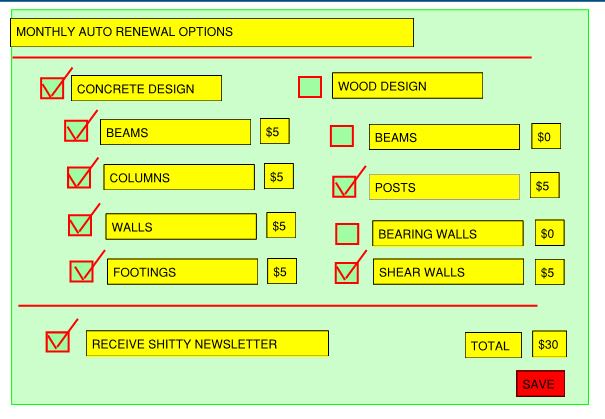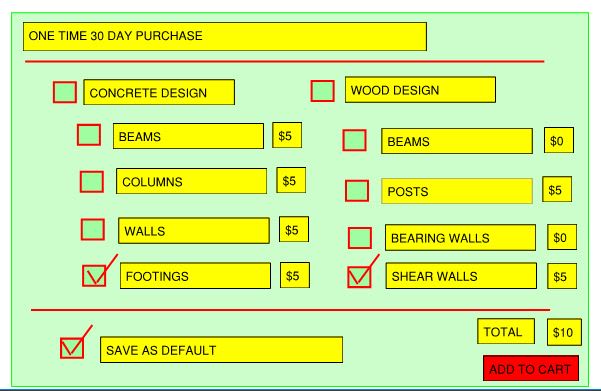The Mission
While I'm still above grade, I intend to create a suite of pay for play, online structural engineering tools (KootWare). And I feel that a big part of making this questionable venture a success -- or at least improving the odds of a contained failure -- will be arriving at a good pricing model. Frankly, this is something that I feel that other developers have done poorly, to their detriment. As such, I'd like to solicit feedback from the hive with respect to the pricing models that I'll propose below and any possibilities for improvement.
The Basics of What You Need to Know About the Offering
1) 100% online offering. No option for a local, perpetual license version.
2) The goal here is not to get rich. The goal is to extract enough income from this that I can justify pouring a lot of effort into a project that I expect to enjoy a great deal.
3) Spit balling, if I could create enough value that I could convince 1000 SE's to part with $5/month, that would be enough. Or any other combination of numbers that gets to the same place. How many software using structural engineers do we think exist in North America anyhow? Sixteen? Eighty thousand? I really don't know.
4) Think something along the lines of TEDDS, ENERCALC, or Jabacus on steroids. I do have ideas for, in my opinion, greatly improving upon these offerings. I'd like that to be a separate conversation however. For now, make a leap of faith and just assume that it will be awesome.
5) I intend to attach some manner of structural only, online forum to the offering. While it would be a free-form space for conversation, as Eng-Tips is, it's ostensible purpose would be to provide a place for me to provide responsive help to anybody designing stuff utilizing the software. Thus making the whole thing even more fun for me. This would be offered in addition to the usual help guide and verification manuals etc <-- edit added per skeletron's comments.
Some Obvservations that I Have Regarding the Pricing Models of Others
6) For software of this type, I feel that a monthly subscription pricing scheme would not be well received. As a small outfit my self, I loathe taking on any additional "monthlys", no matter how great the ROI seems to be. I'm always afraid that I'll use it twice and forget to cancel. I doubt that I'm the only one who feels this way.
7) I also don't think that a straight "pay per use" model is the way to go either. Design is an iterative process and software licensing needs to reflect that. Sadly, I don't just design a shear wall once. I probably design it half a dozen times before all is said and done. And I can't be losing my shirt on pay per use while going through that process.
8) One has to assume that anything that can be abused, will be abused. This will prevent me from being quite as customer friendly as I would otherwise wish to be. My own IP halo gets a little dirty from time to time so no judgement here.
Pricing Model A
This is my favorite of the two and would appeal to me as a customer. Keep in mind than none of the particular values are set in any way. It's really more about the structure at this point. That said, if anybody has thoughts on what the numbers ought to be, I'd welcome that too. I figure I'll adjust as use data starts to pile up but I'll still have to start somewhere.
1) Create an account at KootWare International and add a credit card, paypal etc.
2) Buy yourself some quantity KootWare credits. $10. $100. Whatever. Little gold doubloons in your digital purse.
3) To access the retaining wall tool for use, you pay $5. After the first run, you have the lesser of 20 additional runs or 60 days to keep using the tool on the original $5. One "run" would represent one execution of a full design with detailed output. <-- added per skeletron's comments.
4) If you want to share your account login and credits with somebody else, that's your prerogative. Share it with your coworker, a school chum in Brisbane, your aunt... retaining walls for everybody on that original $5. But, no matter who's using, it taps out after 20 runs or 60 days.
Pricing Model B
1) Create an account at KootWare International and add a credit card, paypal etc.
2) Buy yourself some quantity KootWare credits. $10. $100. Whatever.
3) You can use any tool your like, for free, but you can't get a detailed printout for your calcs until some money has changed hands. The software would tell you the basics of what passed and what failed and would allow you to save your file to the system for future retrieval. I kind of like this in that it would allow one to essentially do their preliminary design work for free. I could allow folks to printout their inputs in case they were worried about my going bankrupt before they get to IFC.
4) When you've got all your design settled and ready for final calc documentation, it's $5 per print. The trouble with this is, I couldn't let the user see the detailed printout ahead of paying for it. Otherwise, I'll wind up with a bunch of folks just doing screen capture etc.
While I'm still above grade, I intend to create a suite of pay for play, online structural engineering tools (KootWare). And I feel that a big part of making this questionable venture a success -- or at least improving the odds of a contained failure -- will be arriving at a good pricing model. Frankly, this is something that I feel that other developers have done poorly, to their detriment. As such, I'd like to solicit feedback from the hive with respect to the pricing models that I'll propose below and any possibilities for improvement.
The Basics of What You Need to Know About the Offering
1) 100% online offering. No option for a local, perpetual license version.
2) The goal here is not to get rich. The goal is to extract enough income from this that I can justify pouring a lot of effort into a project that I expect to enjoy a great deal.
3) Spit balling, if I could create enough value that I could convince 1000 SE's to part with $5/month, that would be enough. Or any other combination of numbers that gets to the same place. How many software using structural engineers do we think exist in North America anyhow? Sixteen? Eighty thousand? I really don't know.
4) Think something along the lines of TEDDS, ENERCALC, or Jabacus on steroids. I do have ideas for, in my opinion, greatly improving upon these offerings. I'd like that to be a separate conversation however. For now, make a leap of faith and just assume that it will be awesome.
5) I intend to attach some manner of structural only, online forum to the offering. While it would be a free-form space for conversation, as Eng-Tips is, it's ostensible purpose would be to provide a place for me to provide responsive help to anybody designing stuff utilizing the software. Thus making the whole thing even more fun for me. This would be offered in addition to the usual help guide and verification manuals etc <-- edit added per skeletron's comments.
Some Obvservations that I Have Regarding the Pricing Models of Others
6) For software of this type, I feel that a monthly subscription pricing scheme would not be well received. As a small outfit my self, I loathe taking on any additional "monthlys", no matter how great the ROI seems to be. I'm always afraid that I'll use it twice and forget to cancel. I doubt that I'm the only one who feels this way.
7) I also don't think that a straight "pay per use" model is the way to go either. Design is an iterative process and software licensing needs to reflect that. Sadly, I don't just design a shear wall once. I probably design it half a dozen times before all is said and done. And I can't be losing my shirt on pay per use while going through that process.
8) One has to assume that anything that can be abused, will be abused. This will prevent me from being quite as customer friendly as I would otherwise wish to be. My own IP halo gets a little dirty from time to time so no judgement here.
Pricing Model A
This is my favorite of the two and would appeal to me as a customer. Keep in mind than none of the particular values are set in any way. It's really more about the structure at this point. That said, if anybody has thoughts on what the numbers ought to be, I'd welcome that too. I figure I'll adjust as use data starts to pile up but I'll still have to start somewhere.
1) Create an account at KootWare International and add a credit card, paypal etc.
2) Buy yourself some quantity KootWare credits. $10. $100. Whatever. Little gold doubloons in your digital purse.
3) To access the retaining wall tool for use, you pay $5. After the first run, you have the lesser of 20 additional runs or 60 days to keep using the tool on the original $5. One "run" would represent one execution of a full design with detailed output. <-- added per skeletron's comments.
4) If you want to share your account login and credits with somebody else, that's your prerogative. Share it with your coworker, a school chum in Brisbane, your aunt... retaining walls for everybody on that original $5. But, no matter who's using, it taps out after 20 runs or 60 days.
Pricing Model B
1) Create an account at KootWare International and add a credit card, paypal etc.
2) Buy yourself some quantity KootWare credits. $10. $100. Whatever.
3) You can use any tool your like, for free, but you can't get a detailed printout for your calcs until some money has changed hands. The software would tell you the basics of what passed and what failed and would allow you to save your file to the system for future retrieval. I kind of like this in that it would allow one to essentially do their preliminary design work for free. I could allow folks to printout their inputs in case they were worried about my going bankrupt before they get to IFC.
4) When you've got all your design settled and ready for final calc documentation, it's $5 per print. The trouble with this is, I couldn't let the user see the detailed printout ahead of paying for it. Otherwise, I'll wind up with a bunch of folks just doing screen capture etc.



![[bigglasses] [bigglasses] [bigglasses]](/data/assets/smilies/bigglasses.gif) (I realise it's just a mock-up, but my eyes are almost bleeding here)
(I realise it's just a mock-up, but my eyes are almost bleeding here)